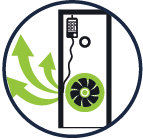
Net Zero Energy
Building Zero Energy
Born out of the uniquely personal commitment of our founder, Brightwater Homes was intentionally designed to be a unique homebuilding company – one where sustainability and environmental responsibility are daily priorities to build better, healthier new homes. Today, it’s a passion that the whole Brightwater team shares and it is brought to life in our Net Zero Energy Building initiative.

What does Net Zero Energy mean?
Brightwater Homes founding partner Charlie Bostwick explains the definition of a Zero Energy home and the components that make it a Zero Energy home. Watch our series on Net Zero Energy.
A Net Zero Energy home is so efficient that it produces at least as much energy as it consumes over the course of a year, leaving the homeowner with a net zero energy bill. In other words, a Net Zero home achieves a HERS® (Home Energy Rating System) Index score of 0. The HERS® Index is the nationally recognized standard by which a home’s energy efficiency is measured. HERS® ratings are determined by a third-party certified home energy rater who assesses the energy efficiency of the home and assigns it a relative performance score compared to a standard reference home of the same size and shape.

The lower the HERS® score number, the more energy efficient the home is. The standard reference home is a 100 on the HERS® scale. So, a home with a HERS® score of 70 is 30% more efficient than that standard new home, while a HERS® score of 130 is 30% less efficient than the standard. Many factors go into the HERS® rating evaluation including a top to bottom inspection of exterior walls both above and below grade, floors over unconditioned spaces like garages or basements, ceiling and roof, attic, foundation, crawlspace, windows and doors, vents and ductwork, HVAC systems and water heating systems.

What are the key benefits of a
Net Zero Energy home?
 Enhanced Savings
Enhanced Savings
A Net Zero Energy home produces as much energy as it uses over the course of a year, leaving the homeowner with a net zero energy bill. That means thousands of dollars in savings in the cost to own and operate your home.
 Environmental Impact
Environmental Impact
By offsetting any draw on finite energy resources, a
New Zero Energy home minimizes its own impact on the environment, helping to preserve and protect it for generations to come.
 Health & Comfort
Health & Comfort
The high performance of a Net Zero Energy home means a cleaner, healthier environment for your life thanks to products and systems that are designed to reduce airborne pollutants and to improve the indoor environment.
 Higher Resale Value
Higher Resale Value
Because they are built to such high quality and
performance standards, Net Zero Energy homes hold their value and generally command measurably higher resale prices.

How do we get to Net Zero Energy?
A great deal of design, engineering and building technology goes into meeting the rigorous performance standards it takes to create a Net Zero home. Here are just a few keys that make the difference in a Brightwater home.
Building toward Zero Energy starts before construction itself. It really all starts with the design phase. Watch our series on Net Zero Energy.

Solar Energy Systems
A Net Zero Energy home produces as much energy as it uses over the course of a year, leaving the homeowner with a net zero energy bill. That means thousands of dollars in savings in the cost to own and operate your home.

A Smart Envelope
As we build for Net Zero Energy, we seek out every possible way to maximize the efficiency of performance of every material we use. Staggered stud walls create continuous insulation, like a blanket wrapped around the house, and greatly improve the air seal as well. This technique is combined with the use of a safe, non-toxic open cell spray foam insulation for the walls and the underside of the roof which provides superior insulating performance and avoids the gaps of traditional batting or blown-in insulation.

High Performance Heating & Cooling
Extremely high efficiency in heating and cooling is critical to achieving Net Zero Energy. That’s why Brightwater uses single, zoned, variable speed 18 SEER electrical HVAC systems from Lennox® with 2 or 3 thermostats depending on the home. Not only are these systems highly efficient, but the variable speed minimizes starts and stops which means less electricity usage, less noise and better humidity management. Brightwater also uses Rinnai® tankless water heaters with a recirculation pump which learns your home’s routines and recirculates based on your schedule– maximizing both efficiency and comfort.

A Tight Seal
Anywhere that a home leaks air, it essentially leaks energy. So one of the keys to achieving Net Zero Energy performance is to ensure a tightly sealed home. The tightness of a home’s seal is measured through third-party blower door testing. A calibrated fan is installed in an otherwise sealed doorway while all other exterior openings are closed. When the fan is turned on, it creates a pressure differential between the inside and outside, allowing testers to measure the amount of air leaking from the home. The standard metric for a blower door test is called ACH50 and indicates how many times the volume of air in the house changes per hour how quickly the air is leaking from the home. The lower the ACH50, the less air leakage there is. While current building standards look for an ACH50 of 5, Brightwater’s target for ACH50 is 1 – meaning 5 times less air leakage than the current standard.
The Net Zero Energy Home has been modeled with a zero (0) Home Energy Rating Score (HERS). The HERS Index Score is a measurement of a home’s energy efficiency per RESNET standards, but it is not a warranty or guarantee of energy utility costs or savings. Even as the home is modeled in the software as designed and built per the relevant home plan, actual energy utility costs will depend on a number of factors, including but not limited to personal utility usage preferences, the rates, fees and charges of local energy utility provides, daily activities, home maintenance practices, household size, use and/or condition of appliances, lighting and internal climate control systems, and the surrounding climate and weather conditions.
